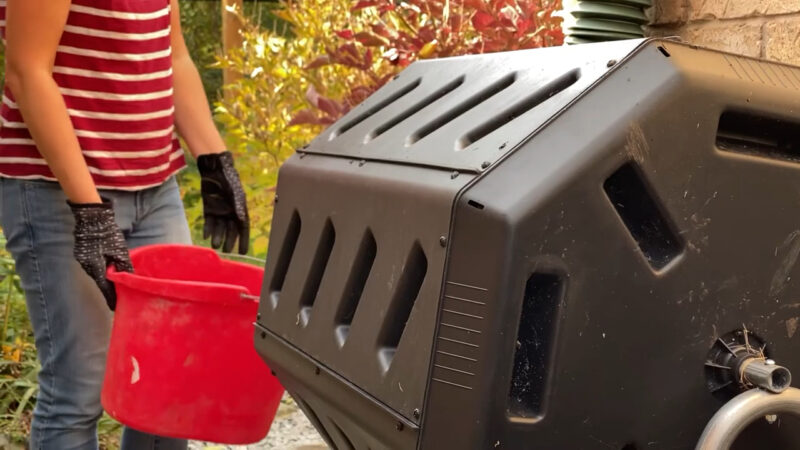Composting is a highly effective method to recycle kitchen scraps and yard waste into nutrient-rich soil. It’s not only an eco-friendly practice, but it can also reduce waste and help gardens flourish without the need for chemical fertilizers. Tumbling composters have revolutionized the composting process, making it more accessible and less labor-intensive.
These devices feature a drum or bin that can be rotated to mix the compost, speeding up decomposition by allowing for better aeration and easy mixing. I’ve evaluated numerous models for effectiveness, ease of use, and build quality to guide you to the best tumbling composter for your garden.
Finding the right composter will revolutionize your gardening experience and yield richer soil for your plants.
Using the FCMP Outdoor IM4000 was a breeze, I must say. The large openings made adding kitchen scraps effortless. The dual chambers allowed me to keep adding to one side while the other matured, ensuring a steady supply of compost. Its rotation system felt smooth, even when the bin was near capacity, making aerating its contents easy without straining my back. I appreciated its resilience to the weather. The composter held up well in my yard through seasonal changes, untouched by rust thanks to its galvanized steel frame. The fact that it’s manufactured from recycled materials not only contributes to its durability but also aligns with my personal ethos of environmental responsibility. Some friends have noted they found the assembly a little tricky, but I managed it without too much hassle. I’ve done so by attaching the panels requires some attention to align everything correctly. Although it’s quite spacious, I could see how those with a larger volume of waste might need something bigger.
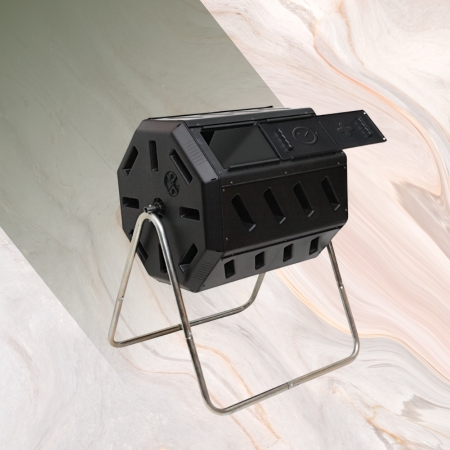
![]() Price Range:$84,99- $99,95
Price Range:$84,99- $99,95
2. Miracle-Gro Compost Tumbler
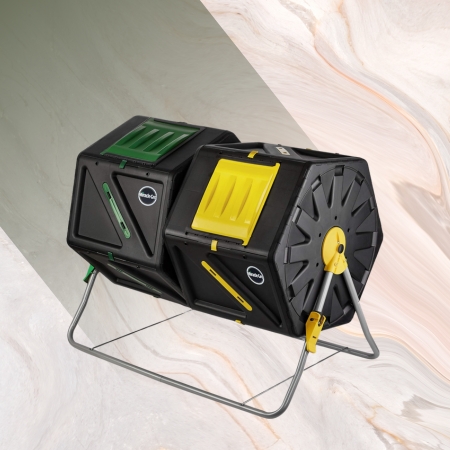
My first impression of the Miracle-Gro Compost Tumbler was its sleek, black design, which complemented my garden tools. The hexagonal shape provided added stability when I loaded it with kitchen scraps and garden clippings. The tumbling action was smooth, making it a cinch to turn even when heavily loaded.
And true to promise, I noticed the materials breaking down at a faster pace than with my previous bin. In no time, I was sprinkling nutrient-rich compost around my tomatoes and basil. Admittedly, I did spend a couple of hours assembling the tumbler, but the effort was worthwhile.
Despite concerns about the rigidity of certain parts, this tumbler held up well to the task. However, for those with larger gardens, the size might be limiting, as frequent emptying becomes a necessity.
- Dual chambers allow for continuous composting cycles
- The assembly is straightforward
- Providing compost in as little as 4-6 weeks
- Initial assembly can be time-consuming
- Some parts may appear flimsy but rest assured they hold up
- It could feel small for gardens generating lots of waste
3. Outsunny Dual Chamber Composter
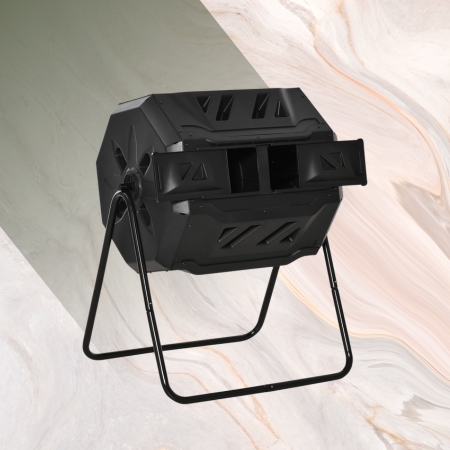
I noticed the convenience of having dual chambers. While one side works on breaking down waste into rich compost, I add fresh scraps to the other, keeping my compost production constant. The 360-degree rotation system is a back saver, eliminating the need for strenuous mixing with a pitchfork or shovel. I just turn the bin every couple of days, keeping the consistency perfect without any hassle.
Addressing the cons, it’s worth noting that the assembly took me a bit longer than expected. It’s not a one-person job, but with a little patience, I managed to set it up. When a strong gust of wind rolled through my yard, I noticed that the composter could use some anchoring or additional weight at the base to keep it grounded – something to think about depending on where you live.
- Two compartments allow continuous composting
- Effortlessly rotates to save you from manually turning compost
- Well-ventilated for quicker decomposition
- Can be challenging to assemble on your own In windy conditions
- The structure may require extra securing
- The sliding doors could be sturdier and more user-friendly
4. EnviroTumbler
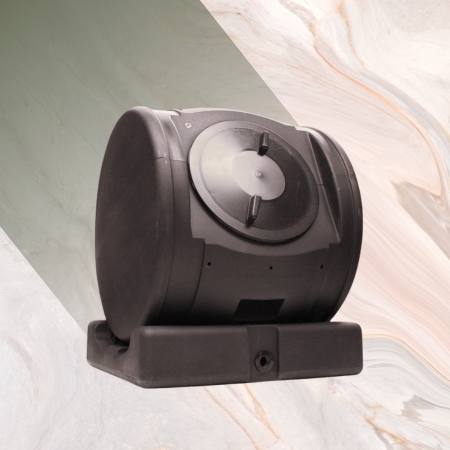
EnviroTumbler’s design is one of its strong sides. I got to composting almost immediately since there was no assembly to worry about. This makes it perfect for individuals like me who prefer less fuss with setup. I’ve noticed the dark color really does absorb heat well, which seems to quicken the breakdown of my kitchen and yard waste.
Within just a few weeks, I was already observing signs of rich, usable compost. The plus point that stands out is the base with integrated wheels. This design makes turning the compost a natural and less back-breaking exercise compared to static bins. And when I need to move my compost closer to my garden, the detachable drum feature comes in handy.
- Setup was a breeze right out of the box
- The dark color efficiently absorbs heat
- Innovative base design with wheels
- Turning the composter can be challenging
- Plastic construction
- It lacks a spigot for dispensing compost tea
5. Upcycled Compost Tumbler
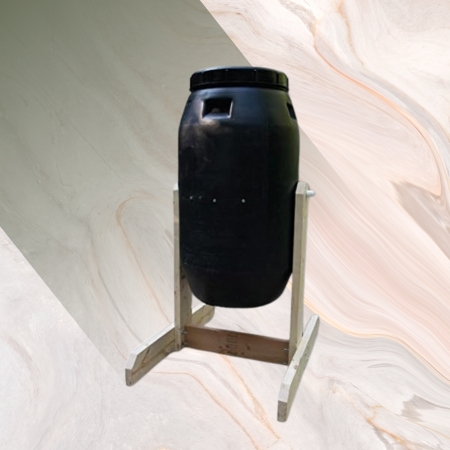
I had the chance to test the Upcycled Compost Tumbler some months ago, and I must admit, it’s a mixed bag. The concept of repurposing a food-grade barrel for composting is brilliant from an ecological standpoint. Assembling it, though, proved to be quite the exercise in patience. The pre-drilled holes were helpful, but the overall construction was not as straightforward as I’d hoped.
Once assembled, I placed the tumbler in a sunny spot in my yard. The black material did a great job absorbing heat, accelerating the breakdown of compost materials. That said, it stood out like a sore thumb amidst my garden’s greenery—a minor aesthetic quirk I learned to live with.
Considering functionality relative to price, I find it hard to justify the cost. There are options on the market offering more value per dollar. The single chamber does limit batch size and flexibility compared to dual-chamber models. Nevertheless, this tumbler serves its purpose and supports a greener lifestyle.
- Utilizes solar heat to break down compost quickly
- Elevated design
- Supports sustainability by upcycling food-grade barrels
- Assembly can be more difficult than expected
- Overall build feels overpriced given the materials
Buying Guide
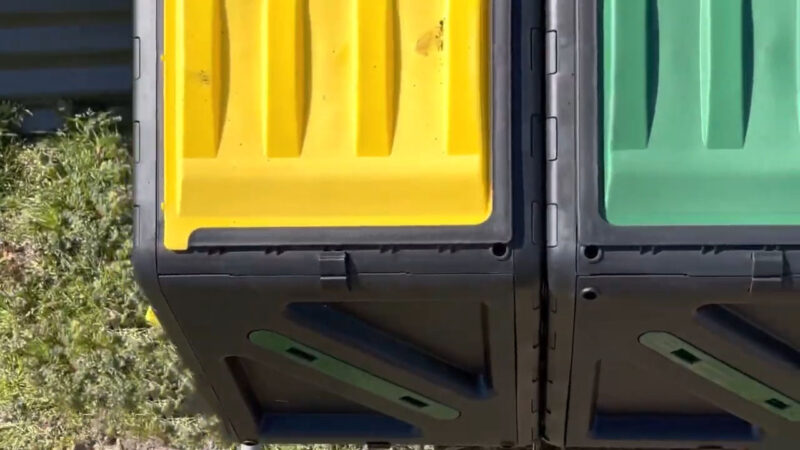
When selecting a tumbling composter, I consider several features to ensure I make the best choice. Here’s what to keep in mind:
Capacity
When determining the appropriate size for a compost bin, I start by evaluating the capacity required. This decision is influenced by two key factors: the volume of organic waste generated by my household and the dimensions of my garden space. For those with a smaller garden or generating less organic waste, a compost bin with a capacity ranging from 30 to 50 gallons is usually sufficient.
This size is compact yet effective for modest composting needs. In cases where the garden is of medium size and the household produces an average amount of organic waste, a compost bin with a capacity between 50 and 80 gallons is more suitable.
This range offers a balanced solution, accommodating a higher volume of waste without occupying too much space. For larger gardens or households that produce a significant amount of organic waste, opting for a compost bin with a capacity of over 80 gallons is advisable. These larger bins can handle greater quantities of waste, making them ideal for more extensive composting requirements.
| Garden Size | Waste Production | Recommended Compost Bin Capacity |
|---|---|---|
| Small garden | Less waste | 30-50 gallons |
| Medium garden | Average waste | 50-80 gallons |
| Large garden | More waste | 80+ gallons |
Materials and Durability
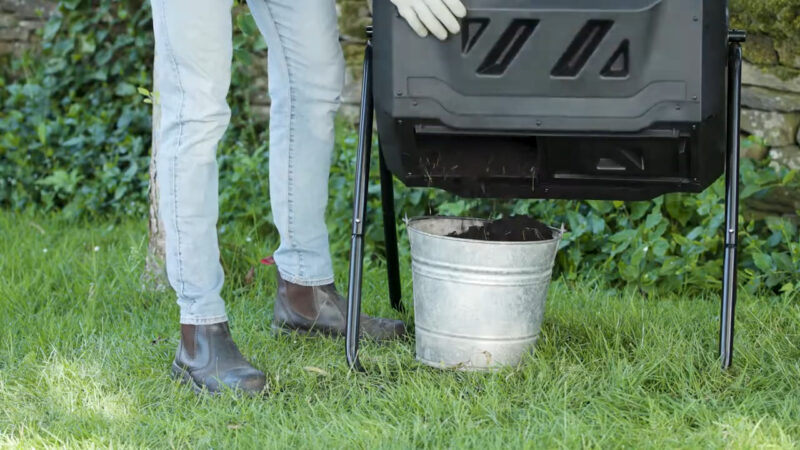
I pay close attention to the materials used in its construction and their durability, especially considering the outdoor environment it will be exposed to. My preference leans towards composters crafted from either UV-protected plastics that are food-grade and BPA-free, or metals that have been coated for extra protection. The use of UV-protected plastic is crucial.
This feature helps to prevent the composter from cracking or degrading under the harsh rays of the sun. By maintaining its structural integrity over time, the composter remains effective and safe for use. Opting for food-grade materials is another important aspect.
This ensures that the composter is safe for handling organic waste, which is essential for producing healthy and uncontaminated compost. It’s a way to guarantee that the compost will be suitable for enriching the soil without introducing any harmful chemicals.
Lastly, the choice of coated metal as a material is driven by its ability to resist rust. Metal composters, when properly coated, can withstand rain, humidity, and other wet conditions without corroding. This prolongs the lifespan of the composter and ensures it remains functional and aesthetically pleasing for years to come.
Tumbling Mechanism
the tumbling mechanism’s efficiency stands out as a key factor. I look for designs that incorporate a handle, which significantly eases the process of turning the compost. Additionally, I favor models that are equipped with features ensuring thorough mixing of the compost material. The presence of a handle is not just a convenience; it’s a crucial element that facilitates regular and effortless turning of the compost.
This is important because regular turning accelerates the composting process and ensures even decomposition of the material. A handle makes this task less labor-intensive, encouraging more frequent turning. In addition to a handle, the inclusion of mixing bars within the composter plays a vital role.
These bars enhance the aeration of the compost, which is essential for breaking down organic matter efficiently. They help in evenly distributing air and moisture throughout the compost, which not only speeds up the composting process but also results in a more uniform and higher-quality end product. Aeration is another critical aspect of composting.
Good airflow is essential for the microbial activity that drives the composting process. Therefore, I pay close attention to aeration features such as vents or holes in the composter design. These features must be adequately sized and positioned to ensure sufficient air circulation.
It’s a delicate balance; the vents or holes must be large enough to allow air to enter and circulate, but not so large that they permit the compost material to spill out. Proper aeration ensures faster decomposition, reduces odors and produces higher-quality compost.
Aeration
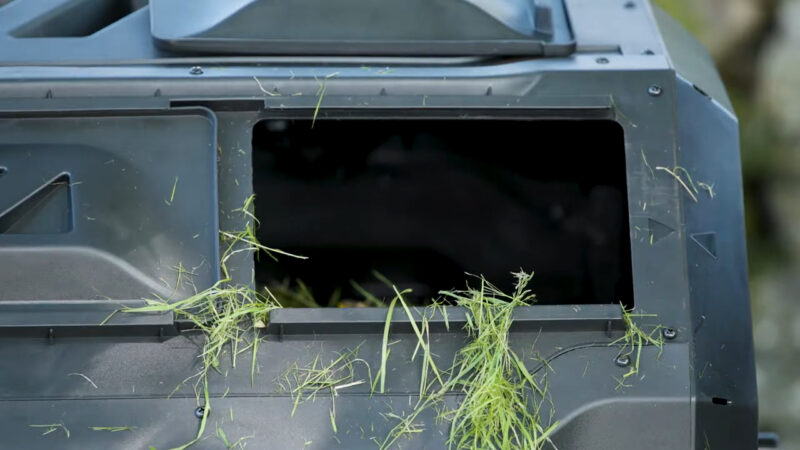
Aeration plays a pivotal role in the composting process, and its importance cannot be overstated. Ensuring good airflow is crucial for facilitating the breakdown of organic materials into compost. To achieve this, I meticulously examine composters for specific aeration features like vents or holes, which are integral to maintaining the right balance in the composting environment.
The presence and design of vents or holes in a composter are critical. These features must be strategically placed and sized to provide optimal air circulation. Adequate airflow is essential because it supports the aerobic bacteria that break down organic matter. Without sufficient oxygen, these bacteria cannot thrive, which can slow down the composting process or lead to anaerobic conditions that produce unpleasant odors.
Ease of Use
Lastly, I consider how easy the composter is to use and especially to fill and empty. A large opening is beneficial, and a low-height design makes it easier to collect compost. Large Opening: A composter with a large opening is crucial for a hassle-free experience. This design element serves two primary purposes:
- Easy Filling: A large opening allows for effortless addition of compost materials, such as kitchen scraps and yard waste, without spilling. It accommodates larger items and reduces the need to break down materials into smaller pieces.
- Simple Removal: When compost is ready, a large opening facilitates the easy extraction of the finished product. It allows for the use of tools like shovels or compost scoops without being hindered by a narrow space.
- Low Height: The height of the composter plays a significant role in its user-friendliness.
- Convenient Compost Collection: A composter with a lower height makes it easier to access and collect the compost. This is particularly beneficial for individuals who might find it challenging to lift heavy materials from a high container.
- Ease of Use for All Ages: A lower height design is also advantageous for children or individuals with limited mobility, making composting an inclusive activity for the entire family or community.
Consider searching for more similar products:
No products found.
FAQs
The Bottom Line
I’ve examined various tumbling composters and highlighted their advantages, ranging from dual chambers for continuous composting to UV-resistant materials that ensure longevity. Capacity, durability, and ease of use are primary factors I considered essential for making an informed decision.
My analysis of tumbling composters reaffirms their value in sustainable waste management and improving soil health. I recommend these innovative tools for gardeners and environmentally conscious individuals aiming to enrich their gardens while reducing waste footprint.
Related Posts:
- How to Reduce Your Pool's Environmental Impact - 2024 Guide
- 10 Best Books on Climate Change in 2024 - In-Depth…
- Best 13 Composting Toilets For Tiny Houses in 2024
- 10 Best Eco-Friendly Water Bottles in 2024:…
- Sea Level Rise: A Watery Warning for Our Future
- 20 Ways to Reduce Climate Change - Save Our Planet


